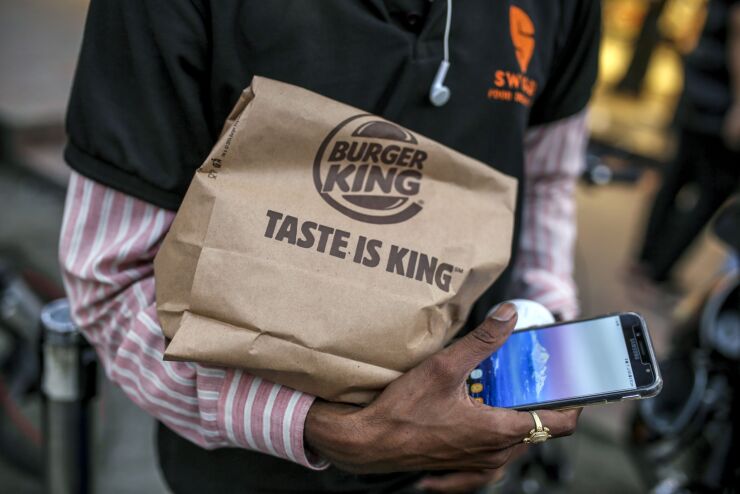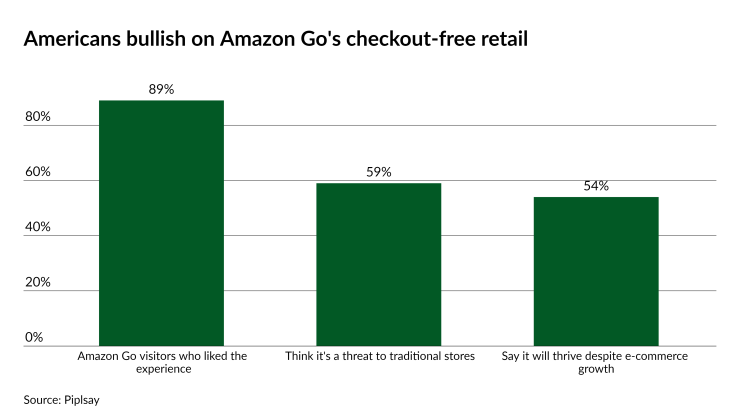The U.S. Military Academy sits at the head of Main Street in the Hudson Valley town of Highland Falls, N.Y., an ideal setting for college-town shops like quick serve restaurants. Here, Chipotle recently chose a spot yards from West Point's imposing gates as a proving ground for its digital kitchen.
It's a restaurant with no dining room or service line. Most of the dining experience takes place on an app, website or third-party order platform. And Chipotle sees this as more than a COVID line-busting concept in a high-volume location.
People can still look into the kitchen from the lobby, hear the cooks and smell the food. There's a sense of permanence. Chipotle imagines a future in which people will want the experience of a restaurant without actually having to spend 90 minutes inside.
"We use real culinary techniques without microwaves or freezers in our kitchens," said Tabassum Zalotrawala, chief development officer at Chipotle, in an email, adding the chain is evaluating the best locations for future expansion. "The prototype will allow Chipoltle to enter more areas that can't support a full-size restaurant and allows flexibility for future locations."
To manage the rush of restaurant technology, Chipotle has opened a Cultivate Center in Irvine, Calif., near its corporate headquarters. The center hosts space to develop new menu items, but also includes a unit for design and construction that builds and tests restaurant prototypes before piloting in the field.

Chipotle's prototype store is part of a revolution in the sale of food. Supermarkets and restaurants have had very different economic experiences during the pandemic — restaurants have struggled, while supermarkets have in some cases thrived. But both sides of the food industry are investing heavily in mobile technology, crowd workarounds and e-commerce.
And 2020 was only an appetizer to the multiple courses of automation that lay ahead for grocery stores and restaurants of all kinds.
Tech on the menu
Because sit-down restaurants typically ask patrons to hand a card or cash to wait staff, the category has long resisted payment innovations such as contactless cards and mobile wallets. There's a lot of catching up to do — and a sharp rise in demand as restaurants plan for post-pandemic life.
Restaurant technology company Toast is reportedly planning an
The end result will make the phone the front end of the customer journey. Installing an app will be much more crucial than choosing a payment at checkout; the payment itself would be an afterthought, if it's visible at all.

"You see it in restaurants that have gone to order-ahead, digital menus, and social media for marketing campaigns," said Mark Waring, senior associate with Strawhecker Group.
Waring began using digital delivery services in the San Francisco Bay Area when the pandemic hit, adding he previously felt he would never need at-home delivery.
"It was a great experience, finding the right restaurant, choosing food, tracking delivery, making a payment and providing a tip," Waring said. "The lesson is for those who lean heavily into understanding thcredit e digital world, they have done it better than most and will continue to do so in the future."
These workarounds are likely to continue for most of the coming year as state and local markets adjust policies. That creates a challenge and a chance to update order and pay technology to make it more flexible, according to Frank Pagano, co-founder and executive sales director for VizyPay, a small-business credit card processing company.
"Online ordering has become more prevalent as well as pay-at-the-table options," Pagano said. "QR codes have also come into the fold not only for menus but a lot of the [point of sale] companies have incorporated them into receipts so the consumer can pay at the table."
The underlying factors that spurred the digital wave have not gone away, creating pressure for restaurants to build a permanent solution for consumers who aren't as willing to eat in dining rooms as in the past.
While 33% of Americans say they are looking forward to dining out again, more than a quarter say they won't feel comfortable inside a restaurant until vaccinated, according to research firm
"While we’ll probably go back to traditional menus post-pandemic, using a QR code for payment has real value for the merchant as it delivers a pay-at-table capability at a very low cost," said Thad Peterson, a senior analyst at Aite.
The transaction is card-not-present if a QR code is used for payment, thus making it more expensive than a card-present transaction, but the overall interaction would be less expensive for the restaurant because it would not tie up wait staff, Peterson said.
"We’re all aware of how quickly things changed overnight, so it’s important to consider that just because something works well today, doesn’t mean it will tomorrow, and adapt your business accordingly," Pagano said. "Phones can only accommodate so many orders per hour and for many restaurants were the only way they've accepted to-go orders in the past."
Innovation on aisle zero
Checkout-free retail got put through its paces early in the pandemic when stores in
Amazon Go — a largely cashless and contactless convenience store — was the early bellwether in autonomous checkout, but as the supermarket world has been turned upside down, the attention in the next year will be on firms that can make the technology work in larger venues.
Amazon has reached out to shopping malls, entering a partnership with mall operator Simon Property Group to use mall space for a mix of fulfillment and potential locations for larger

Other checkout-free companies are seeking adoption and drawing investors.
Amazon Go, Standard Cognition and the nearly two dozen firms that are building checkout-free technology use an array of sensors to track consumers as they pick up and carry out items, charging their accounts after they leave the store.
"Honestly, computer vision is the most disruptive thing to happen to the retail industry in decades," said Alex Plant, head of marketing at Standard Cognition.
Standard Cognition is betting on the contactless commerce trend creating more demand for checkout-free stores. The vendor competes with firms such as Grabango and Zippin to place autonomous checkout inside stores, providing shopping data for incentive marketing and managing traffic inside stores.
SoftBank Vision Fund 2* led the latest Standard Cognition investment, and the vendor's new deployments include Alimentation Couche-Tard, the parent company of Circle K and Compass Group. That deployment will deploy checkout-free technology at several hundred stores in the next year as part of Standard Cognition's larger goal of reaching 50,000 locations in the next five years. SoftBank Investment Advisors sees the investment as vital in the battle for physical retail to keep up with online commerce.
Since it's unlikely supermarkets will entirely abandon in-person checkout, chains are making investments in delivery and mobile technology, similar to how restaurants are evolving.
"We're not going to see normal foot traffic at stores in general until 2022," said Greg Sterling, vice president of Uberall, a Berlin-based location-based marketing company, who anticipates "vaccine marketing" as stores tie local vaccination rates to enticements to come into stores.
For the overall food industry, there's a gap between pent-up demand and people actually feeling comfortable enough to go to stores, Sterling said. That will keep the onus on delivery, mobile and other workarounds such as outdoor pickup.
Beyond Amazon, one of the major retailers to watch in the next year will be Walmart, which has an influential fintech partnership with
Less cutting-edge measures will become more popular at supermarkets and other retail categories. The process of buying online and picking up in store has emerged as a way to shorten delivery windows for e-commerce orders. For food, it allows fast orders without consumers needing to enter the store. Writing for
"Buy online, pick up at the curb (BOPAC) has become a standard offering at many supermarkets and consumers appreciate the convenience and time savings provided by the service," Peterson said, adding grocery delivery services like Instacart have also taken off because of the pandemic. "It’s likely that both BOPAC and delivery will continue to thrive in the future."
David Heun contributed to this story.





